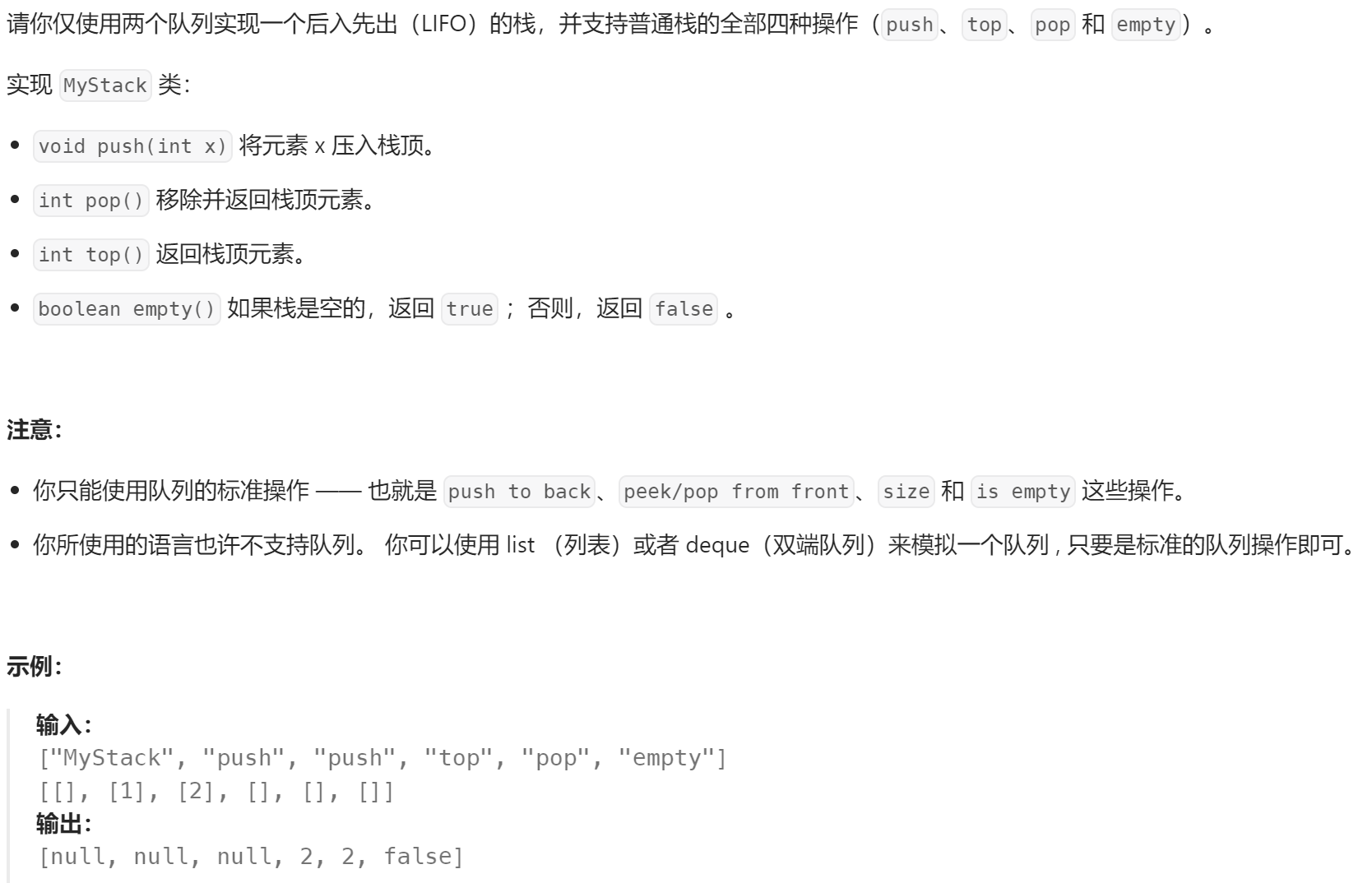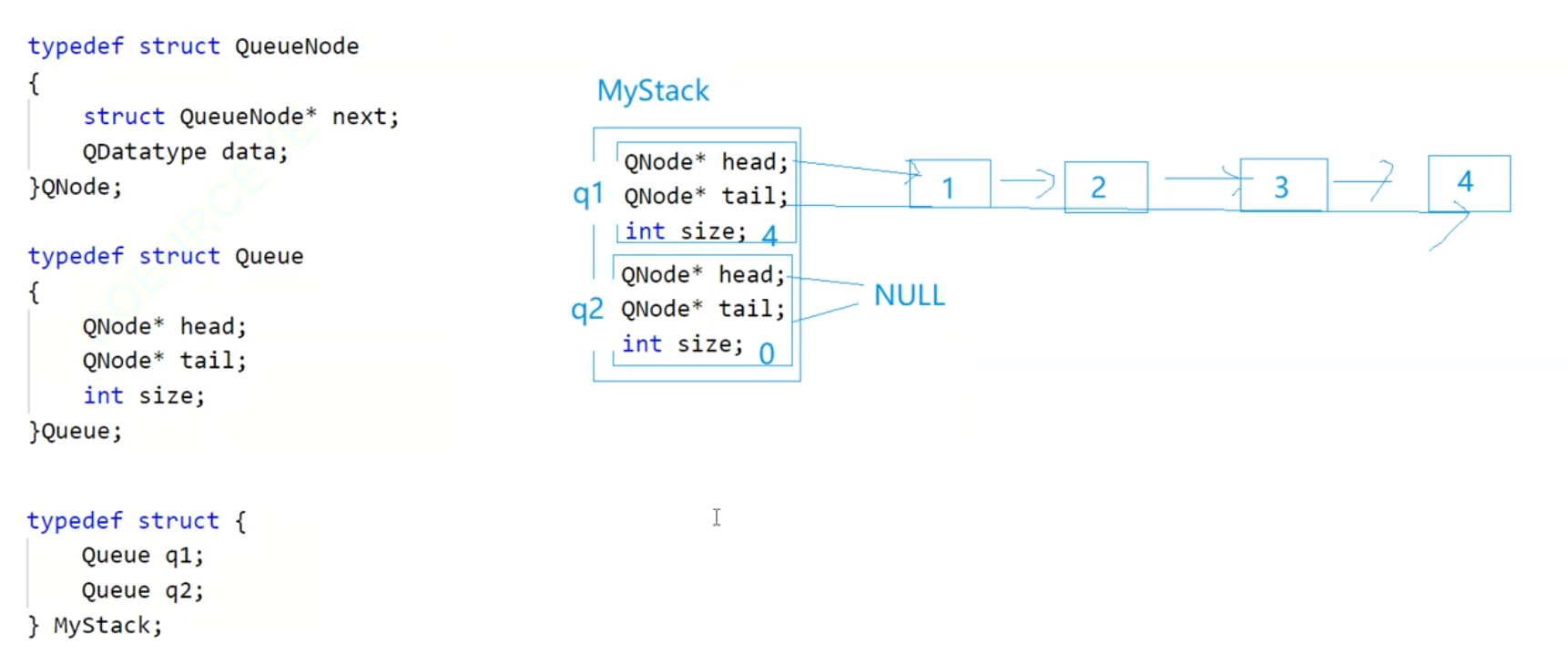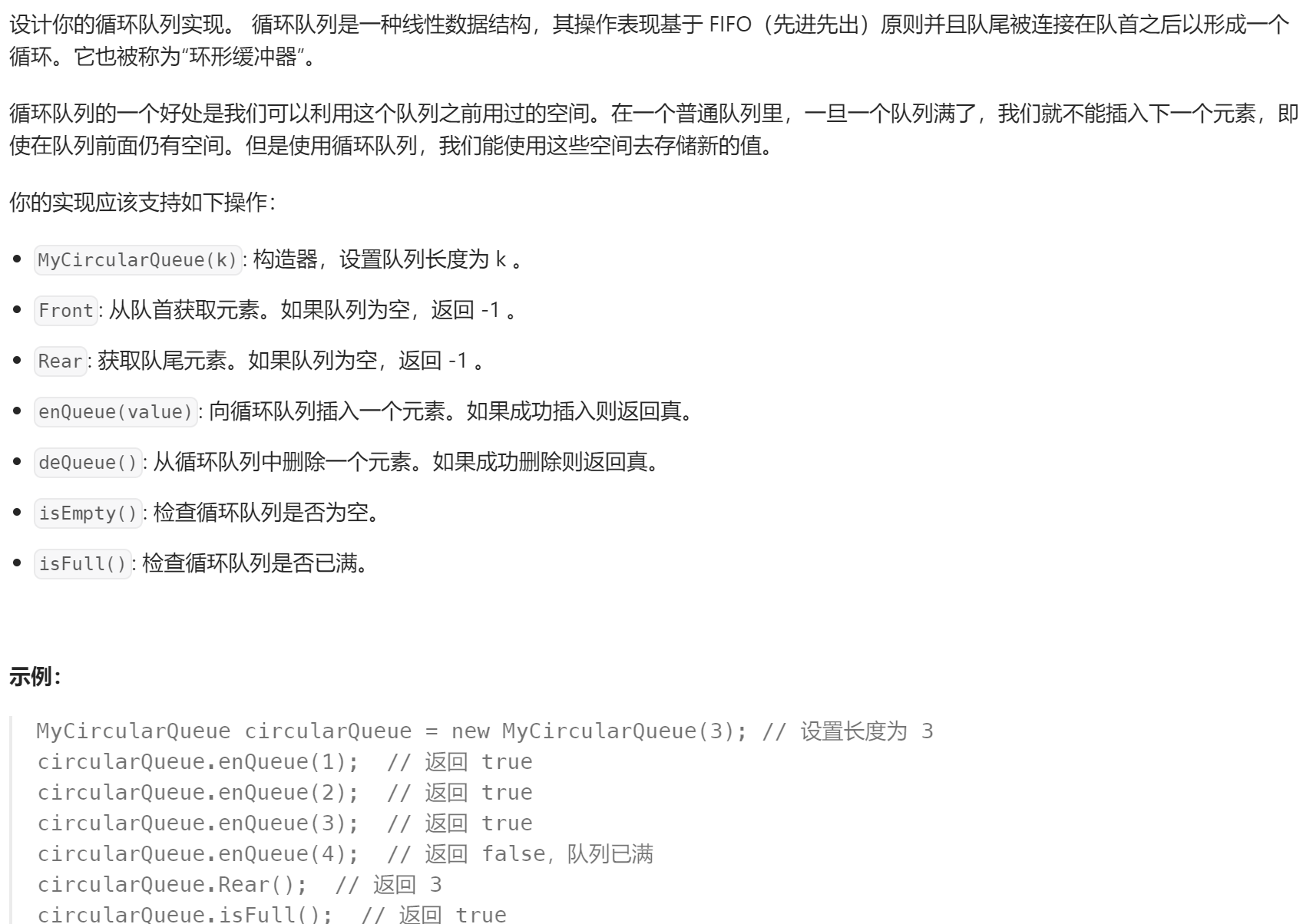1.用队列实现栈
225. 用队列实现栈 - 力扣(LeetCode)


typedef int QDatatype;
typedef struct QueueNode
{
struct QueueNode *next;
QDatatype data;
}QNode;
typedef struct Queue
{
QNode* head;
QNode* tail;
QDatatype size;
}Que;
typedef struct
{
Que q1;
Que q2;
} MyStack;
void QueueInit(Que* pq);
void QueueDestroy(Que* pq);
void QueuePush(Que* pq, QDatatype x);
void QueuePop(Que* pq);
int QueueSize(Que* pq);
bool QueueEmpty(Que* pq);
QDatatype QueueFront(Que* pq);//队头数据
QDatatype QueueBack(Que* pq);//队尾数据
void QueueInit(Que* pq)
{
assert(pq);
pq->head = pq->tail = NULL;
pq->size = 0;
}
void QueueDestroy(Que* pq)
{
assert(pq);
QNode* cur = pq->head;
while (cur)
{
QNode* next = cur->next;
free(cur);
cur = next;
}
pq->head = pq->tail = NULL;
pq->size = 0;
}
void QueuePush(Que* pq, QDatatype x)
{
QNode* newnode = (QNode*)malloc(sizeof(QNode));
if (newnode==NULL)
{
perror("malloc fail");
return;
}
newnode->data = x;
newnode->next = NULL;
if (pq->head == NULL)
{
assert(pq->tail == NULL);
pq->head = pq->tail = newnode;
}
else
{
pq->tail->next = newnode;
pq->tail = newnode;
}
pq->size++;
}
void QueuePop(Que* pq)
{
assert(pq);
assert(pq->head != NULL);
QNode* oldhead = pq->head;
pq->head = pq->head->next;
free(oldhead);
if (pq->head == NULL)
{
pq->tail = NULL;
}
pq->size--;
}
int QueueSize(Que* pq)
{
assert(pq);
return pq->size;
}
bool QueueEmpty(Que* pq)
{
assert(pq);
return pq->size == 0;
}
QDatatype QueueFront(Que* pq)
{
assert(pq);
assert(!QueueEmpty(pq));
return pq->head->data;
}
QDatatype QueueBack(Que* pq)
{
assert(pq);
assert(!QueueEmpty(pq));
return pq->tail->data;
}
MyStack* myStackCreate()
{
MyStack*pst=(MyStack*)malloc(sizeof(MyStack));
if(pst==NULL)
{
perror("malloc fail");
return NULL;
}
QueueInit(&pst->q1);
QueueInit(&pst->q2);
return pst;
}
void myStackPush(MyStack* obj, int x)
{
if(!QueueEmpty(&obj->q1))
{
QueuePush(&obj->q1,x);
}
else
{
QueuePush(&obj->q2,x);
}
}
int myStackPop(MyStack* obj)
{
assert(obj != NULL);
Que* emptyQ = NULL;
Que* noneemptyQ = NULL;
// 确定哪个队列是非空的
if (!QueueEmpty(&obj->q1) && QueueEmpty(&obj->q2))
{
noneemptyQ = &obj->q1;
emptyQ = &obj->q2;
}
else if (QueueEmpty(&obj->q1) && !QueueEmpty(&obj->q2))
{
noneemptyQ = &obj->q2;
emptyQ = &obj->q1;
}
else
{
// 两个队列都为空,栈为空
return -1;
}
// 将非空队列的元素(除最后一个外)移到空队列
while (QueueSize(noneemptyQ) > 1)
{
QueuePush(emptyQ, QueueFront(noneemptyQ));
QueuePop(noneemptyQ);
}
// 最后一个元素是栈顶
int top = QueueFront(noneemptyQ);
QueuePop(noneemptyQ);
return top;
}
int myStackTop(MyStack* obj)
{
if(!QueueEmpty(&obj->q1))
{
return QueueBack(&obj->q1);
}
else
{
return QueueBack(&obj->q2);
}
}
bool myStackEmpty(MyStack* obj)
{
return(QueueEmpty(&obj->q1)&&QueueEmpty(&obj->q2));
}
void myStackFree(MyStack* obj)
{
QueueDestroy(&obj->q1);
QueueDestroy(&obj->q2);
free(obj);
}
2.用栈实现队列
232. 用栈实现队列 - 力扣(LeetCode)

typedef int STDataType;
typedef struct Stack
{
int* a;
int top;
int capacity;
}ST;
typedef struct
{
ST Popst;
ST Pushst;
} MyQueue;
void STInit(ST* ps);
void STDestroy(ST* ps);
void STPush(ST* ps,STDataType x);
void STPop(ST* ps);
int STSize(ST* ps);
bool STEmpty(ST* ps);
STDataType STTop(ST* ps);
void STInit(ST* ps)
{
assert(ps);
ps->a = (STDataType*)malloc(sizeof(STDataType) * 4);
if (ps->a == NULL)
{
perror("malloc fail");
return;
}
ps->capacity = 4;
ps->top = 0;//top是栈顶元素的下一位置
}
void STDestroy(ST* ps)
{
assert(ps);
free(ps->a);
ps->a = NULL;
ps->capacity = 0;
ps->top = 0;
}
void STPush(ST* ps, STDataType x)
{
assert(ps);
if (ps->top == ps->capacity)
{
STDataType*tmp = (STDataType*)realloc(ps->a,sizeof(STDataType) * ps->capacity*2);
if (tmp == NULL)
{
perror("malloc fail");
return;
}
ps->a = tmp;
ps->capacity *= 2;
}
ps->a[ps->top] = x;
ps->top++;
}
void STPop(ST* ps)
{
assert(ps);
assert(!STEmpty(ps));
ps->top--;
}
int STSize(ST* ps)
{
assert(ps);
return ps->top;
}
bool STEmpty(ST* ps)
{
assert(ps);
return ps->top == 0;
}
STDataType STTop(ST* ps)
{
assert(ps);
assert(!STEmpty(ps));
return ps->a[ps->top - 1];
}
MyQueue* myQueueCreate()
{
MyQueue*obj=(MyQueue*)malloc(sizeof(MyQueue));
if(obj==NULL)
{
perror("malloc fail");
return NULL;
}
STInit(&obj->Pushst);
STInit(&obj->Popst);
return obj;
}
void myQueuePush(MyQueue* obj, int x)
{
STPush(&obj->Pushst,x);
}
int myQueuePeek(MyQueue* obj)
{
if(STEmpty(&obj->Popst))
{
while(!STEmpty(&obj->Pushst))
{
STPush(&obj->Popst,STTop(&obj->Pushst));
STPop(&obj->Pushst);
}
}
return STTop(&obj->Popst);
}
int myQueuePop(MyQueue* obj)
{
int front=myQueuePeek(obj);
STPop(&obj->Popst);
return front;
}
bool myQueueEmpty(MyQueue* obj)
{
return(STEmpty(&obj->Pushst)&&STEmpty(&obj->Popst));
}
void myQueueFree(MyQueue* obj)
{
STDestroy(&obj->Pushst);
STDestroy(&obj->Popst);
free(obj);
}
3.设计循环队列
622. 设计循环队列 - 力扣(LeetCode)

typedef struct {
int*a;
int k;
int front;
int rear;
} MyCircularQueue;
MyCircularQueue* myCircularQueueCreate(int k) {
MyCircularQueue*obj=(MyCircularQueue*)malloc(sizeof(MyCircularQueue));
obj->front=obj->rear=0;
obj->a=(int*)malloc(sizeof(int)*(k+1));
obj->k=k;
return obj;
}
bool myCircularQueueIsEmpty(MyCircularQueue* obj) {
return obj->front==obj->rear;
}
bool myCircularQueueIsFull(MyCircularQueue* obj) {
return (obj->rear+1)%(obj->k+1)==obj->front;
}
bool myCircularQueueEnQueue(MyCircularQueue* obj, int value) {
if(myCircularQueueIsFull(obj))
return false;
obj->a[obj->rear++]=value;
obj->rear%=(obj->k+1);
return true;
}
bool myCircularQueueDeQueue(MyCircularQueue* obj) {
if(myCircularQueueIsEmpty(obj))
return false;
++obj->front;
obj->front%=(obj->k+1);
return true;
}
int myCircularQueueFront(MyCircularQueue* obj) {
if(myCircularQueueIsEmpty(obj))
return -1;
else
return obj->a[obj->front];
}
int myCircularQueueRear(MyCircularQueue* obj) {
if(myCircularQueueIsEmpty(obj))
return -1;
else
return obj->a[(obj->rear-1+obj->k+1)%(obj->k+1)];
}
void myCircularQueueFree(MyCircularQueue* obj) {
free(obj->a);
free(obj);
}



